Expo 58
| 1958 Brussels | |
|---|---|
 The Philips Pavilion | |
| Overview | |
| BIE-class | Universal exposition |
| Category | First category General Exposition |
| Name | Expo 58 |
| Area | 2 square kilometres (490 acres) |
| Visitors | 41,454,412 |
| Participant(s) | |
| Countries | 44 |
| Location | |
| Country | Belgium |
| City | Brussels |
| Venue | Heysel |
| Coordinates | 50°53′50″N 4°20′21″E / 50.89722°N 4.33917°E |
| Timeline | |
| Bidding | 7 May 1948 |
| Awarded | November 1953 |
| Opening | 17 April 1958 |
| Closure | 19 October 1958 |
| Universal expositions | |
| Previous | Exposition internationale du bicentenaire de Port-au-Prince in Port-au-Prince |
| Next | Century 21 Exposition in Seattle |
| Specialized Expositions | |
| Previous | Interbau in Berlin |
| Next | Expo 61 in Turin |
| Horticultural expositions | |
| Next | Floriade 1960 in Rotterdam |
Expo 58, also known as the Brussels World’s Fair (Dutch: Brusselse Wereldtentoonstelling, French: Exposition Universelle et Internationale de Bruxelles), was held from 17 April to 19 October 1958.[1] It was the first major World Expo registered under the Bureau International des Expositions (BIE) after World War II.
Background
Nearly 15,000 workers spent three years building the 2 km2 (490 acres) site on the Heysel plateau, 7 kilometres (4.3 mi) northwest of central Brussels, Belgium. Many of the buildings were re-used from the Brussels International Exposition of 1935, which had been held on the same site.[2]
Every 25 years starting in 1855, Belgium had staged large national events to celebrate its national independence following the Belgian Revolution of 1830. However, the Belgian government under prime minister Achille Van Acker decided to forego celebrations in 1955 to have additional funding for the 1958 Expo.[3]
Expo 58 was the 11th World's Fair hosted by Belgium, and the fifth in Brussels, following the fairs in 1888, 1897, 1910 and 1935. Since Expo 58, Belgium has not arranged any more world fairs.
Exhibition
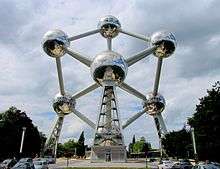
The site is best known for the Atomium, a giant model of a unit cell of an iron crystal (each sphere representing an atom). More than 41 million visitors visited the site,[4] which was opened with a call for world peace and social and economic progress, issued by King Baudouin I.
Notable exhibitions include the Philips Pavilion, where "Poème électronique", commissioned specifically for the location, was played back from 425 loudspeakers, placed at specific points as designed by Iannis Xenakis, and Le Corbusier.
Another exhibition at the Belgian pavilion was the Congolese village that some have branded a human zoo.[5]
National pavilions
Austria
The Austrian pavilion was designed by Austrian architect Karl Schwanzer in modernist style. It was later transferred to Vienna to host the museum of the 20th century. In 2011 it was reopened under the new name 21er Haus. It included a model Austrian Kindergarten, which doubled as a day care facility for the employees, the Vienna Philharmonic playing behind glass, and a model nuclear fusion reactor that fired every 5 minutes.
Czechoslovakia
The exposition "One Day in Czechoslovakia" was designed by Jindřich Santar who cooperated with artists Jiří Trnka, Antonín Kybal, Stanislav Libenský and Jan Kotík. Architects of the simple, but modern and graceful construction were František Cubr, Josef Hrubý and Zdeněk Pokorný. The team's artistic freedom, so rare in the hard-line communist regime of the 1950s, was ensured by the government committee for exhibitions chairman František Kahuda. He supported the famous Laterna Magika show, as well as Josef Svoboda's technically unique Polyekran. The Czechoslovak pavilion was visited by 6 million people and was officially awarded the best pavilion of the Expo 58.[6]
Mexico
This was designed by the architect Pedro Ramírez Vázquez. It was awarded the exposition's star of gold.
Paris
The city of Paris had its own pavilion, separate from the French one.
United Kingdom
This was produced by the designer James Gardner, architect Howard Lobb & engineer Felix Samuely. The on-site British architect was Michael Blower, Brussels born and bilingual.[7]
USSR
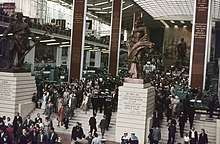
The Soviet pavilion was a large impressive building which they folded up and took back to Russia when Expo 58 ended. They had a facsimile of Sputnik which mysteriously disappeared, and they accused the US of stealing it. They had a bookstore selling science and technology books in English and other languages published by the Moscow Press. On the exposition there was also a model of Lenin first nuclear icebreaker, and cars: GAZ-21 Volga, GAZ-13 Chaika, ZIL-111, Moskvitch 407 and 423, trucks GAZ-53 and MAZ-525.[8] The Soviet exposition was awarded with a Grand Prix.[8]
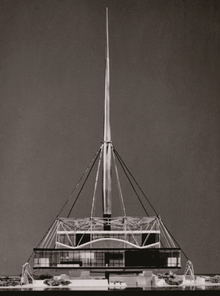
USA
The US pavilion was quite spacious and included a fashion show with models walking down a large spiral staircase, an electronic computer that demonstrated a knowledge of history, and a color television studio behind glass. It also served as the concert venue for performance by the Seventh Army Symphony Orchestra under the direction of Edward Lee Alley.[9][10] It was designed by architect Edward Durell Stone.
Federal Republic of Germany
The West German pavilion was designed by the architects Egon Eiermann and Sep Ruf. The world press called it the most polished and sophisticated pavilion of the exhibition.[11]
Yugoslavia
The pavilion of Yugoslavia was designed by the architect Vjenceslav Richter, who originally proposed to suspend the whole structure from a giant cable-stayed mast. When that proved too complicated, Richter devised a tension column consisting of six steel arches supported by a pre-stressed cable, which stood in front of the pavilion as a visual marker and symbolized Yugoslavia's six constituent republics. Filled with modernist art, the pavilion was praised for its elegance and simplicity and Richter was awarded as Knight of the Order of the Belgian Crown. After the end of Expo 58, the pavilion was sold and reconstructed as a school in the Belgian municipality of Wevelgem, where it still stands.
Gallery
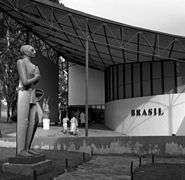 Brazilian pavilion
Brazilian pavilion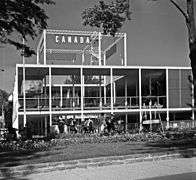 Canadian pavilion
Canadian pavilion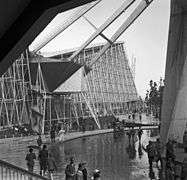 French pavilion
French pavilion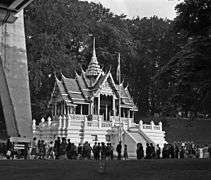 Thai pavilion
Thai pavilion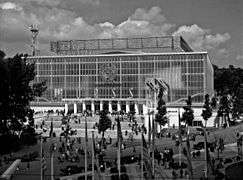 Pavilion of the Soviet Union
Pavilion of the Soviet Union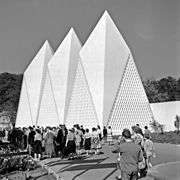 UK pavilion
UK pavilion US pavilion
US pavilion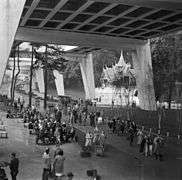 A scene near the Thailand pavilion in July 1958
A scene near the Thailand pavilion in July 1958- West German pavilion
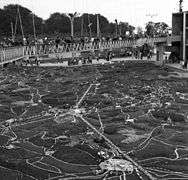 Expo 58 visitors crossing a pedestrian bridge over a three-dimensional scale map of the Belgian landscape, on display near its pavilion in July 1958
Expo 58 visitors crossing a pedestrian bridge over a three-dimensional scale map of the Belgian landscape, on display near its pavilion in July 1958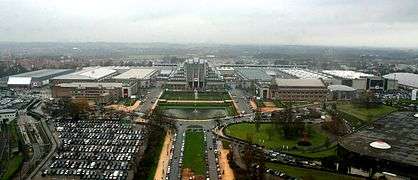 The Centenary Palace in Heysel Park, a centrepiece at the Expo (viewed from the Atomium)
The Centenary Palace in Heysel Park, a centrepiece at the Expo (viewed from the Atomium)
Transport
- As lots of visitors were expected, SABENA temporarily increased capacity by renting a couple of Lockheed Constellations.
- For the same reason, and well in time, it was decided to add a new terminal to the Melsbroek national airport; it was to be at the west side of the airport, on the grounds of the municipality of Zaventem, which has since given its name to the airport. A very modern addition was the railway station in the airport, offering direct train service to the city centre, though not to the expo itself.
- Several tram lines were built to serve the site, those to Brussels remain in service.
Mozart's Requiem incident
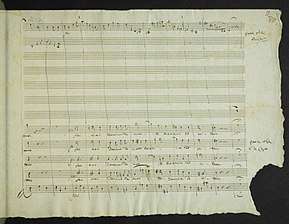
The autograph of Mozart's Requiem was placed on display. At some point, someone was able to gain access to the manuscript, tearing off the bottom right-hand corner of the second to last page (folio 99r/45r), containing the words "Quam olim d: C:". As of 2012 the perpetrator has not been identified and the fragment has not been recovered.[12]
International film poll
The event offered the occasion for the organization by thousands of critics and filmmakers from all over the world, of the first universal film poll in history.[13]
See also
- The logo for Expo 58 was designed by Lucien De Roeck, and posters based on it were produced by De Roeck and by Leo Marfurt
- The 50th anniversary of Expo 58 was selected as the main motif of a high-value collectors' coin: the Belgian 100 euro 50th Anniversary of the International Expo in Belgium commemorative coin, minted in 2008. In the obverse, the logo of the event is depicted together with the number 50, representing its 50th anniversary.
- Brussels International (1897)
- Brussels International (1910)
- Brussels International Exposition (1935)
References
- ↑ "When the world was in Brussels". Flanders Today. April 16, 2008.
- ↑ Video: Brussels World's Fair, 1958/03/17 (1958). Universal Newsreel. 1958. Retrieved February 21, 2012.
- ↑ Expo 58, The Royal Belgian Film Archive, Revised Edition, 2008, p. 78 (booklet accompanying DVD edition of footage from the exhibition)
- ↑ Mattie, Eric (1998). Weltausstellungen (in German). Stuttgart/Zürich: Belser Verlag. p. 201. ISBN 3-7630-2358-5.
- ↑ "Deep Racism: The Forgotten History Of Human Zoos". PopularResistance.Org. 2014-02-18. Retrieved 2014-03-24.
- ↑ MF DNES, Expo 2010, Mimořádná příloha o světové výstavě v Šanghaji, 3.5.2010.
- ↑ See chapter by Jonathan Woodham - Caught between Many Worlds: the British Site at Expo ‘58’(see bibliography)
- 1 2 GAZ-21I «Wołga», "Avtolegendy SSSR" Nr. 6, 2009, DeAgostini, ISSN 2071-095X (in Russian), p.7
- ↑ 7th Army Symphony Choronology Historical timeline of the orchestra on 7as0.org
- ↑ Pan Pipes of Sigma Alpha Iota Vol. 2 p. 47 "Seventh Army Symphony Orchestra performs at the Brussels World Fair 1958 on books.google.com
- ↑ Jones, Peter Blundell; Canniffe, Eamonn (2012). Modern Architecture Through Case Studies 1945 to 1990. Routledge. p. 28. ISBN 978-1-135-14409-8.
- ↑ Facsimile of the manuscript's last page, showing the missing corner Archived 2012-01-13 at the Wayback Machine. from Austrian National Library
- ↑ Władysław Jewsiewicki: "Kronika kinematografii światowej 1895-1964", Warsaw 1967, no ISBN, page 129 (in Polish)
Bibliography
- The Architecture of Expo 58 by Rika Devos & Mil De Kooning (eds). Dexia/Mercatorfonds, 2006.
External links
| Wikimedia Commons has media related to Expo 1958. |
- Official website of the BIE
- Expo '58 and a Flash-based
- Brussels World's Fair approaches completion, a March 17, 1958 Universal newsreel clip from the Internet Archive
- 1958 Brussels from the Bureau International des Expositions website
